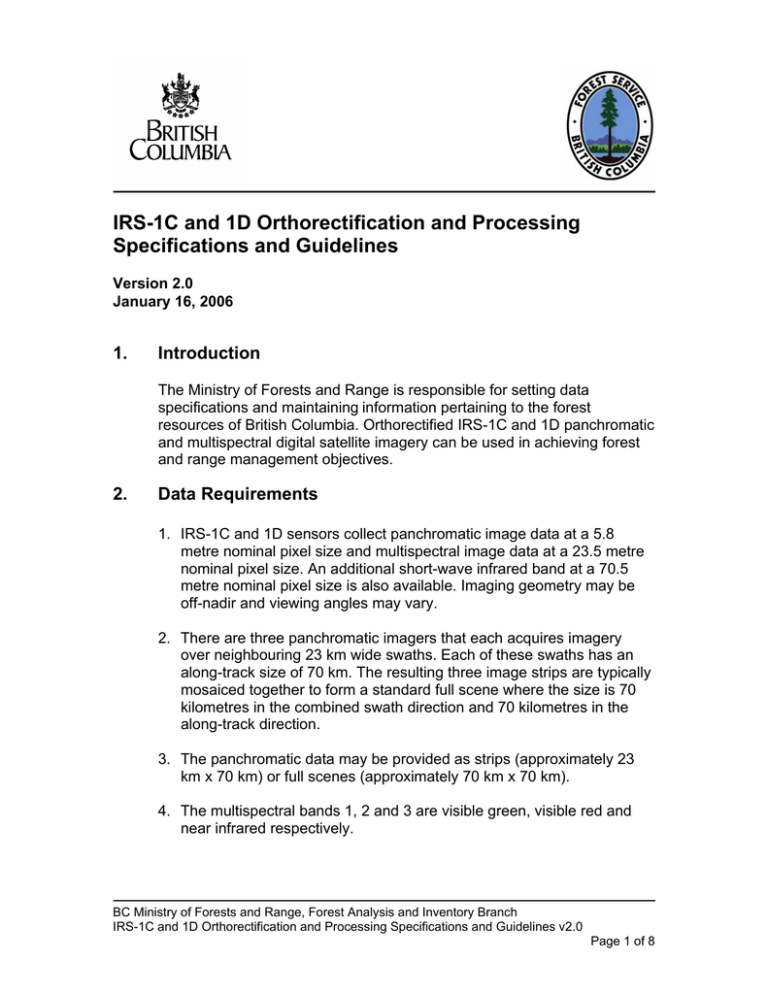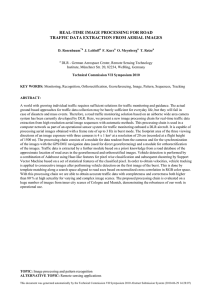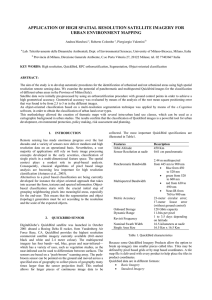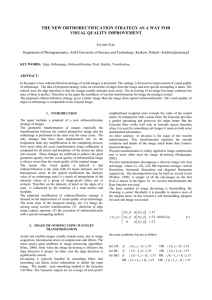IRS-1C and 1D Orthorectification and Processing Specifications and
advertisement

IRS-1C and 1D Orthorectification and Processing Specifications and Guidelines Version 2.0 January 16, 2006 1. Introduction The Ministry of Forests and Range is responsible for setting data specifications and maintaining information pertaining to the forest resources of British Columbia. Orthorectified IRS-1C and 1D panchromatic and multispectral digital satellite imagery can be used in achieving forest and range management objectives. 2. Data Requirements 1. IRS-1C and 1D sensors collect panchromatic image data at a 5.8 metre nominal pixel size and multispectral image data at a 23.5 metre nominal pixel size. An additional short-wave infrared band at a 70.5 metre nominal pixel size is also available. Imaging geometry may be off-nadir and viewing angles may vary. 2. There are three panchromatic imagers that each acquires imagery over neighbouring 23 km wide swaths. Each of these swaths has an along-track size of 70 km. The resulting three image strips are typically mosaiced together to form a standard full scene where the size is 70 kilometres in the combined swath direction and 70 kilometres in the along-track direction. 3. The panchromatic data may be provided as strips (approximately 23 km x 70 km) or full scenes (approximately 70 km x 70 km). 4. The multispectral bands 1, 2 and 3 are visible green, visible red and near infrared respectively. BC Ministry of Forests and Range, Forest Analysis and Inventory Branch IRS-1C and 1D Orthorectification and Processing Specifications and Guidelines v2.0 Page 1 of 8 5. The band 1 to 3 multispectral data is acquired with a swath width of 142 km. The fourth short-wave infrared band is acquired with a swath width of 148 km. 6. For orthogonal geometric correction (orthorectification) of IRS-1C or 1D data, it is recommended that the source format data be in Super Structure or Fast format (with radiometric correction, across track resampling and detector offsets applied), on CD-ROM. 7. Imaging geometry should be as close to nadir as possible to ensure a consistent pixel ground sampling distance. As the off-nadir viewing angle increases, the accuracy of orthorectification transformation will decrease. It is recommended that scenes have a near nadir viewing angle of no more than ±2°. There is an important trade-off between ideal viewing geometry and the likelihood of a cloud-free archived image. Decisions should consider the risk associated with the need for precise positioning of the orthorectified image. 8. Image radiometry It is recommended that the image radiometry of the source data have a minimum acceptable gray level range greater than 32. 9. Ground Control Points (GCPs) should be collected from either 1:20 000 digital Terrain Resource Information Management (TRIM) planimetry vector maps or from differentially corrected Global Positioning System (DGPS) points. GCPs should be well identified features, such as near right angle road intersections, where the position can be interpreted on the ground, on 1:20 000 TRIM maps and on the IRS imagery at sub-pixel precision. Intermittent or indefinite features or temporary features should not be used as GCPs. GCP source data should be in a North American Datum (NAD83 (Canada, National Transform version 1 (NTv1)). 10. TRIM derived gridded Digital Elevation Model (DEM) files must be used in the orthorectification process. These files are 16 bit signed and cover 1:250 000 National Topographic System (NTS) maps with a pixel size of 25 metres. These data are available as ESRI ASCII grid and USGS DEM formatted files. Files are available in both BC Albers standard and UTM projections with appropriate georeferencing information, NAD83 (Canada, NTv1) datum. 3. Orthorectification Orthorectification of strip and full scene IRS data is achieved using either 1:20 000 TRIM planimetric features or DGPS points and gridded Digital Elevation Models (DEM). BC Ministry of Forests and Range, Forest Analysis and Inventory Branch IRS-1C and 1D Orthorectification and Processing Specifications and Guidelines v2.0 Page 2 of 8 1. The image analyses software used for orthorectification purposes must be capable of incorporating and utilizing the data listed above. This includes the digital IRS strips and full scenes, either the TRIM planimetric files or the DGPS points and the gridded DEM data. 2. It is recommended that whenever panchromatic and multispectral data are to be orthorectified, that GCPs be collected for both (i.e. 5.8 metre panchromatic band and 23.5 metre band 3, 2 and 1 colour composite). Sufficient GCPs per strip or full IRS scenes must be collected for use as control in the orthorectification transformation. The GCPs should be well distributed (both horizontally and vertically) and encompass the extents of the image as much as is possible. a) A minimum of 6 GCPs per IRS image strip (either Super Structure or Fast Format) should be collected and used to control the orthorectification process. A minimum of 3 independent check points must also be collected to asses the accuracy of the orthorectification model; or b) A minimum of 20 GCPs per full scene (either Super Structure or Fast Format) should be used to control the orthorectification transformation. A minimum of 9 independent check points should also be collected to asses the accuracy of the orthorectification model. The consistency of fit of the orthorectified data to the TRIM map vectors is a good test of the accuracy of the orthorectification process. 3. If more than one adjoining IRS strip or full scene image is to be orthorectified, stereo GCPs and/or tie points should be collected and used in the overlapping image areas for simultaneous orthorectification. 4. The recommended overall RMS error for GCPs, stereo GCPs, tie points and independent check points is within ±10 metres with a 90% confidence level. It is recommended that the orthorectification process use a cubic convolution resampling routine and that a linear interpolation routine is used on the DEM elevation values in calculating the horizontal corrections. 5. It is recommended that the orthorectification process for Super Structure format IRS data use the co-linearity condition method (Toutin 1995) of geometric modeling to adjust pixel locations to UTM and/or BC Albers standard map projection coordinates in NAD83 (Canada, NTv1). 6. It is recommended that the orthorectification process for Fast format data use the Rational Function method available in PCI’s satellite sensor rectification edition (version 7.0 or greater) or an equivalent method of BC Ministry of Forests and Range, Forest Analysis and Inventory Branch IRS-1C and 1D Orthorectification and Processing Specifications and Guidelines v2.0 Page 3 of 8 geometric modeling to adjust pixel locations to UTM and/or BC Albers projection coordinates in NAD83 (Canada, NTv1). 7. The outside geographic extents of all orthorectified IRS image data must be evenly divisible by 100 metres. 8. The upper left pixel origins for UTM projection files must be calculated using pixel size in Eastings from the Zone meridian and in Northings from the equator. 9. The upper left pixel origins for BC Albers standard projection files must be calculated using pixel size in Eastings from the central meridian of 126° West longitude and in Northings from the latitude of projection origin of 45° North latitude. 4. Image Processing Image processing involves image enhancement, mosaicing and clipping (sub-setting) of orthorectified images into areas of interest. These may include Ministry Regions, Districts, 1:250 000 NTS maps, 1:50 000 NTS maps and/or 1:20 000 BCGS maps. 1. Image enhancement is a process of improving feature interpretability through various techniques, such as adjusting brightness and contrast. The values used to adjust brightness and contrast are stored in a look up table (LUT). LUTs should be created to optimize interpretability of features of interest such as natural and man made disturbances from the surrounding forest canopy. Disturbances include such features as harvesting, roads, fires and pest damage. Enhancements should also optimize gray level balancing of the panchromatic bands and colour balancing of multispectral bands between adjacent scenes while maintaining the variability in the source data (saturation should be avoided). Enhancements must not result in valid spectral reflectance values being changed to null or zero values in the enhanced image. The enhanced images should be used in the mosaic and clipping (subsetting) processes. 2. Mosaicing is the process of joining adjacent and/or overlapping scenes to achieve complete coverage of an area of interest and/or to replace poor image areas (e.g. cloud, haze, or shadow). The mosaicing process should not result in any repositioning of the input pixel coordinates. In order to maintain a clear relationship between images acquired on different dates, blending or feathering of the images along mosaic seam lines is not recommended. BC Ministry of Forests and Range, Forest Analysis and Inventory Branch IRS-1C and 1D Orthorectification and Processing Specifications and Guidelines v2.0 Page 4 of 8 3. Clipping is the process of sub-setting the enhanced orthorectified and mosaiced image into areas of interest that may include Ministry Regions, Districts, 1:50 000 NTS maps and/or 1:20 000 BCGS maps. The geographic extent of each of these image areas should extend beyond their geographic limits by at least 100 metres and be evenly divisible by 100 metres and file origins should be defined in even 100 metres. 5. Deliverables Orthorectification, it is recommended that deliverables for IRS strips and full scenes include: 1. Uncorrected working files in PCIDSK *.pix format. These files must contain the GCP segments used in the orthorectification. 2. A brief report describing the orthorectification procedures used. This report must include an RMS error report for the orthorectification transformation with a listing of all GCPs, independent check points and tie points or altimetric points, a description of the resampling algorithm used, a description of the adjustment process used and a description of all image file geographic extents in NAD83 (Canada, NTv1). Orthorectified data may be requested in both UTM and/or BC Albers standard projection with a NAD83 (Canada, NTv1) datum. 3. Digital image deliverables for orthorectified IRS satellite data may include un-enhanced resampled 5 metre pixel panchromatic band and un-enhanced resampled 20 metre pixel multispectral bands 1, 2 and 3. An intensity hue saturation (IHS) fusion of the IRS panchromatic band together with bands 5, 4 and 3 from Landsat 5 or 7 images may be requested with 5 metre pixels. LUTs used for enhancement of the panchromatic band, bands 5, 4 and 3 of the Landsat image and the IHS fuse in the image processing tasks should be delivered with these data. Data should be delivered in PCIDSK *.pix and/or GeoTIFF *.tif format. 4. The generic file naming scheme for orthorectified IRS full scenes uses lower case letters and is parsed using underscores to separate key pieces of metadata information: satellite-identifier_image-location-identifier_acquisitiondate_projection-identifier-(zone)_pixel-size-(metres)_bandidentifier.file-format-extension BC Ministry of Forests and Range, Forest Analysis and Inventory Branch IRS-1C and 1D Orthorectification and Processing Specifications and Guidelines v2.0 Page 5 of 8 e.g. for an IRS-1D scene, track 253 frame 032, acquired on August 12, 2002, un-enhanced 5 metre panchromatic band, delivered in PCIDSK format: irs1d_253032_20020812_utm11_5m_pan.pix e.g. for data delivered in BC Albers standard projection, replace the projection-identifier with bcalb: irs1d_253032_20020812_bcalb_5m_pan.pix e.g. for un-enhanced 20 metre multispectral bands 1 to 3 delivered in PCIDSK format: irs1d_253032_20020812_utm11_20m_b123.pix Image processing deliverables for enhanced, mosaiced and clipped (subset) images should include: 1. A brief technical report describing enhancements, mosaicing and clipping (sub-setting) of the orthorectified images into areas of interest that may include Ministry Regions, Districts, 1:250 000 NTS maps, 1:50 000 NTS maps and/or 1:20 000 BCGS map areas. 2. This report should include a description of geographic extents of the image files. 3. It is recommended that LUTs used for image enhancement be delivered with the orthorectification deliverables in a suitable digital format for each orthorectified IRS image. The typical enhanced deliverables include the enhanced panchromatic image. If the IRS panchromatic data has been IHS fused with Landsat 5 or 7, the typical enhanced deliverables will also include the Landsat 5 or 7 image bands 5, 4 and 3 as Red, Green and Blue (RGB) and an enhanced IHS fuse of the IRS panchromatic with bands 5, 4 and 3 of the Landsat 5 or 7 multispectral as RGB. 4. It is recommended that the mosaic seams used in the mosaicing process be supplied as a deliverable in a suitable digital polygon vector format. 5. Each orthorectified, enhanced, mosaiced and/or clipped (sub-set) image should be delivered in GeoTIFF *.tif format. BC Ministry of Forests and Range, Forest Analysis and Inventory Branch IRS-1C and 1D Orthorectification and Processing Specifications and Guidelines v2.0 Page 6 of 8 6. The generic file naming scheme for enhanced orthorectified IRS-1C and 1D full scenes uses lower case letters and is parsed using underscores to separate key pieces of metadata information: satellite-identifier_image-location-identifier_acquisitiondate_projection-identifier-(zone)_pixel-size-identifier(metres)_band-identifier_enhanced.file-format-extension e.g. for an IRS-1D scene, track 253 frame 032, acquired on August 12, 2002, enhanced 5 metre panchromatic band, delivered in GeoTIFF format: irs1d_253032_20020812_utm11_5m_pan_enh.tif e.g. for data delivered in BC Albers standard projection, replace the projection-identifier with bcalb: irs1d_253032_20020812_bcalb_5m_pan_enh.tif e.g. for orthorectified and enhanced IHS fuse of the IRS-1D panchromatic with Landsat 7 multispectral bands 5, 4 and 3 as RGB: irs1dl7_253032_20020812_utm11_5m_ihs_enh.tif 7. The generic file naming scheme for IRS image files covering 1:250 000 NTS maps, 1:50 000 NTS maps or 1:20 000 BCGS maps must include the map name identifier as the image-location-identifier in the file name: e.g. for 1:250 000 NTS map 82n: irs1d_94f_20020812_utm11_5m_pan_enh.tif e.g. for 1:50 000 NTS map 82n07: irs1d_82n07_20020812_utm11_5m_pan_enh.tif e.g. for 1:20 000 BCGS map 82n026: irs1d_82n026_20020812_utm11_5m_pan_enh.tif 6. References British Columbia Resource Information Standards Committee (RISC). March 2001. Geographic Data BC. British Columbia Standards, Specifications and Guidelines for Resource Surveys Using Global Positioning System (GPS) Technology. Release 3.0. URL site: http://ilmbwww.gov.bc.ca/risc/pubs/other/index.htm BC Ministry of Forests and Range, Forest Analysis and Inventory Branch IRS-1C and 1D Orthorectification and Processing Specifications and Guidelines v2.0 Page 7 of 8 British Columbia Ministry of Sustainable Resource Management. October 1996. Base Mapping and Geomatic Services Branch. Gridded DEM Specification. Release 1.1. URL site: http://srmwww.gov.bc.ca/bmgs/products/griddem.htm British Columbia Ministry of Sustainable Resource Management. January 1992. Base Mapping and Geomatic Services Branch. British Columbia Specifications and Guidelines for Geomatics, Content Series Volume 3, Digital Baseline mapping at 1:20 000. Release 2.0. Terrain Resource Information Management (TRIM) program. URL site: http://srmwww.gov.bc.ca/bmgs/trim/trim/index.html British Columbia Albers Standard Projection. URL site: http://ilmbwww.gov.bc.ca/risc/pubs/other/mappro/index.htm GeoEye, Orbimage and Space Imaging. URL site: http://www.geoeye.com/ Canadian Earth Observation Network (CEONet). GeoConnections Discovery Portal. URL site: http://geodiscover.cgdi.ca/gdp/index.jsp?language=en USGS Earth Explorer. URL site: http://edcsns17.cr.usgs.gov/cgi-bin/EarthExplorer/phtml/verify_login.phtml USGS Land Processes Distributed Active Archive Center (LP DAAC). URL site: http://edcdaac.usgs.gov/main.asp USGS Global Visualization Viewer. URL site: http://glovis.usgs.gov/ Cheng, P. et. al. March 1998. Unlocking the potential for IRS-1C data. Earth Observation Magazine. Vol. 7. (3). 24-26. Toutin, T. et. al. 1998. Indian remote sensing satellite: geocoding and DEM extraction. Canadian Aeronautics and Space Institute, 20th Remote Sensing Symposium Proceedings. 29-32. Toutin, T. October 1995. Multisource data fusion with an integrated and unified geometric modeling. EARSeL Advances in Remote Sensing. Vol. 4 (2). 118-129. BC Ministry of Forests and Range, Forest Analysis and Inventory Branch IRS-1C and 1D Orthorectification and Processing Specifications and Guidelines v2.0 Page 8 of 8



